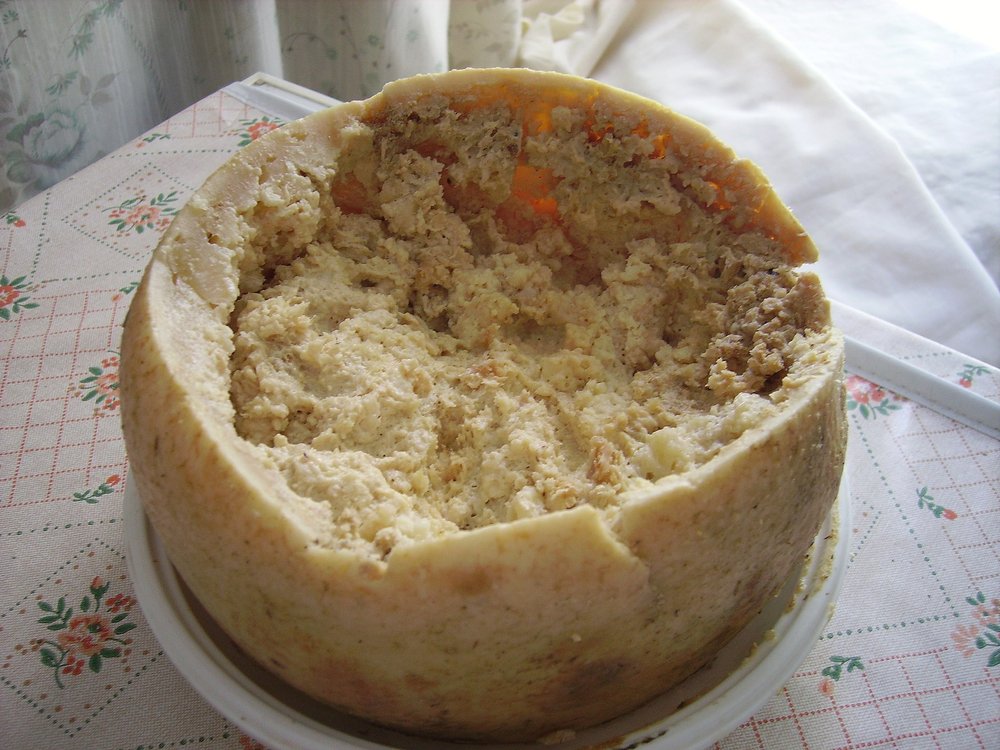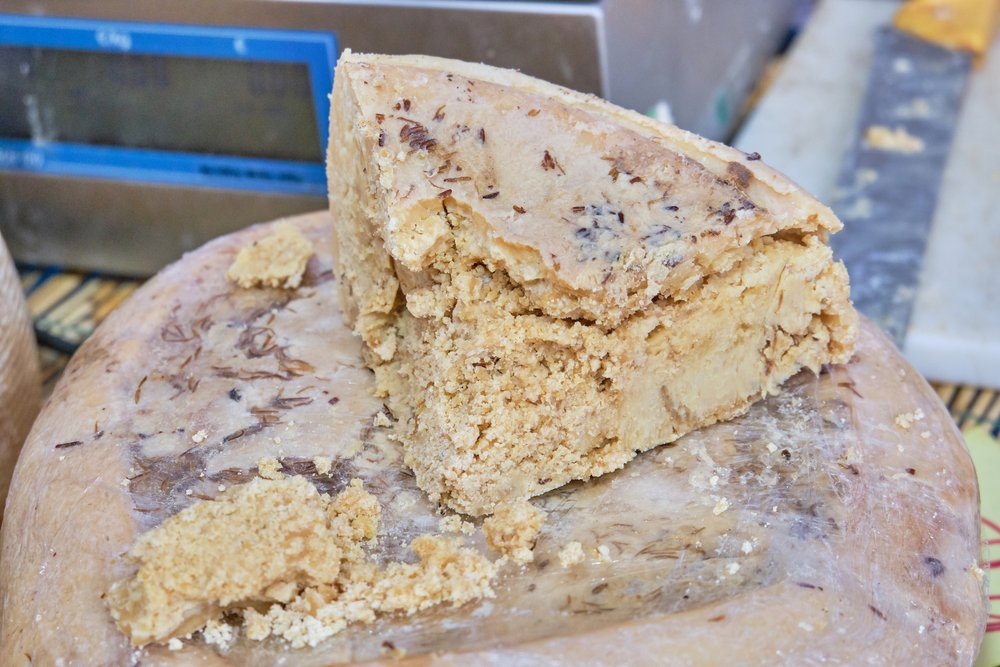Few cheeses on earth are as unique and provocative as Casu Marzu. Often referred to as “the forbidden cheese”, “the maggot cheese”, and even “the world’s most dangerous cheese”, this Sardinian delicacy brings out some strong reactions.
“File:Casu Marzu cheese.jpg” by Shardan is licensed under CC BY-SA 2.5.
How Casu Marzu is Made
The cause of such visceral reactions? The use of the writhing, wriggling larvae of the cheese fly Piophila casei in making it. Made for centuries, this sheep milk cheese starts off the same way as the more user-friendly Pecorino Sardo. At a specific point in the wheel’s development, however, a very different process is introduced.
At just the right point of maturing, the top of each wheel is partially removed, exposing the developing curds. The eggs of the cheese fly are deposited inside, and the rind replaced. When the translucent, white larvae hatch they begin consuming the interior.
Their digestive process causes advanced fermentation to take place, which turns the interior into a soft, creamy texture. (The name, Casu Marzu, translates to “rotting cheese”, a nod to the process it undergoes.) Oozing beads of fatty liquid called lagrima, “tears” in the local dialect, slide down the cut exterior of the wheel as it matures, a sign the process is working as intended.
Once fully matured, it’s time to serve the cheese, maggots and all. Casu Marzu is traditionally served with freshly-baked bread and the local, intense red wine Cannonau. The spicy, bold flavors of the wine match the cheese’s aromatic strength.

How Casu Marzu is Served
Each diner chooses whether or not to eat the fully-grown larvae. Those wishing to partake are strongly advised to wear glasses or, better yet, to place their flattened hand under their nose to prevent the wriggling larvae from launching themselves into an unsuspecting nasal cavity or eye socket.
Diners preferring to avoid contact can place a chunk of the cheese into a paper bag and close it up tightly. A lack of oxygen makes the larvae bounce around, creating a “pitter-patter” sound that diminishes as they suffocate. Once the sound subsides, the cheese can be removed and served. In either case, it is essential the larvae are alive and moving when the cheese is to be eaten. Dead larvae signify the cheese has turned toxic, and should not be consumed.
Illegal Cheese
Banned in just about every country in the world, Casu Marzu can be quite difficult to find, even in Sardinia. Originally banned there as well, a shift in classification allowed the cheese to be considered a “traditional food”, exempting it from most of the food laws in place. Still, finding this delicacy to try can be challenging. It’s mostly sold “under the counter” by locals or made at home.
What it’s Like to Eat Casu Marzu
To gain a better understanding of what it’s like to experience Casu Marzu, I reached out to cheese professional Andiy Wagner, who tried Casu Marzu in Sardinia as a 19-year old, to see what someone with first-hand knowledge thinks.
As it turns out, the encounter began with an unplanned visit to the Mediterranean island. “I took the ferry to Sardinia on a whim,” Wagner recalls. She was amazed at how friendly everyone was, even more so when a dinner invitation was extended. “I appeared apparently lost and was invited to dinner with the locals. I ate amazing food,” she recalls.
Once dinner was finished, a man excused himself from the table and left the room. A few minutes later, he returned carrying a plate. Wagner didn’t know what was on it, but could certainly smell it. “It was…very pungent.”
Wagner had heard of the famous, illegal cheese, but had no idea she was about to try it. The decision to do it came from a promise made at the start of the trip. “I made a rule for myself when it came to the local food. I would try everything at least once,” she says. Without revealing it as Casu Marzu, the host smeared some of the aromatic cheese on a piece of fresh bread and gave it to Wagner, advising her to chew it really well. “They plunked it in front of me when I asked about it,” she shares. “They told me it was good I wore glasses in case the maggots jumped.”
How was it? “It was salty and pungent,” she concedes. “The cheese has an odd texture. It’s not horrible, but odd. It was a little like cream cheese, but with harder bits. Maybe more like cottage cheese,” she considers. “It actually wasn’t as bad as you would think it might be. I mean, the idea of eating maggots wasn’t on my list. But honestly, considering everything I have eaten in my life. Not bad.”
Is there more Casu Marzu in store for the future? Not likely. “It’s one of those experiences I’m not sure I would do again, but it was kinda fun.”
